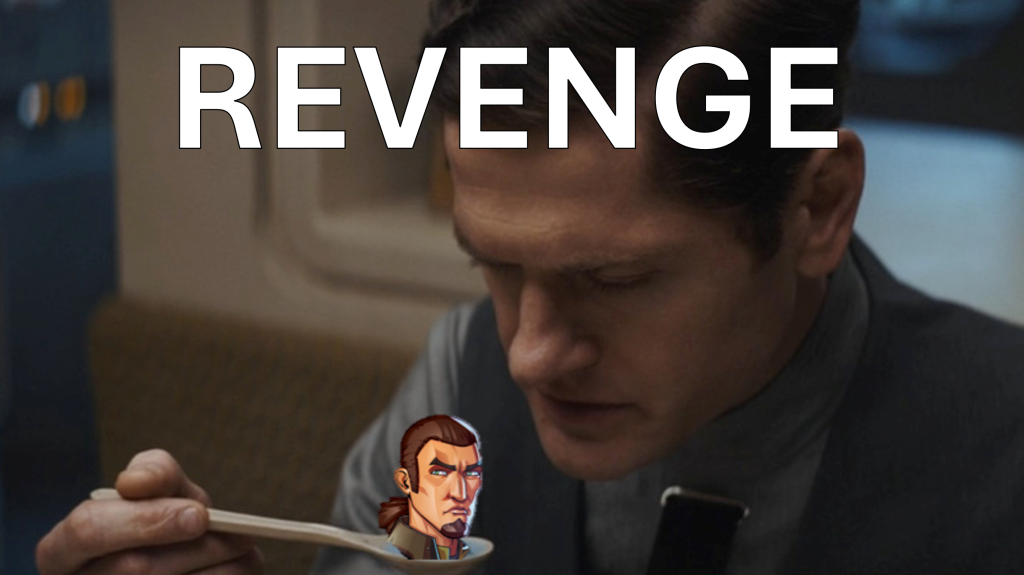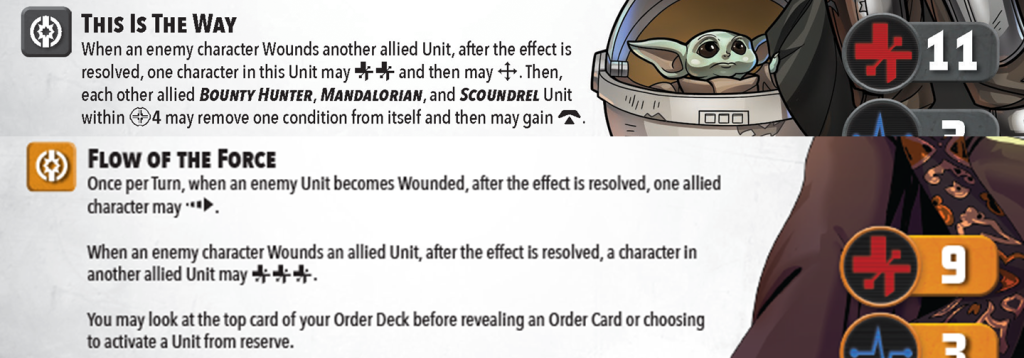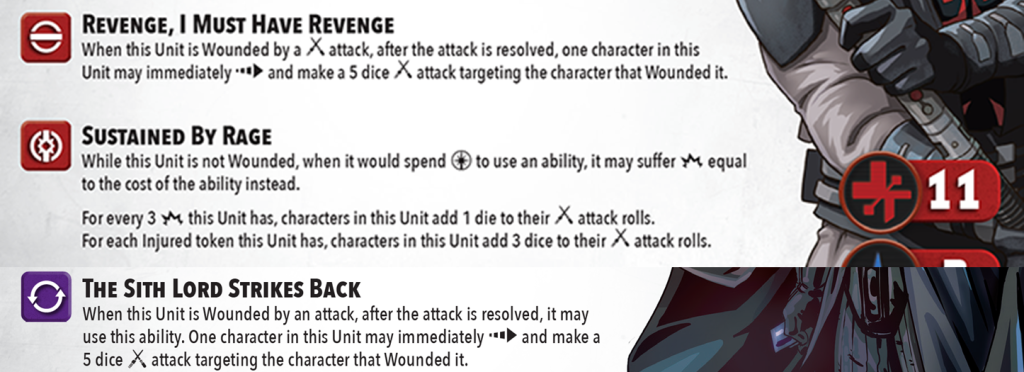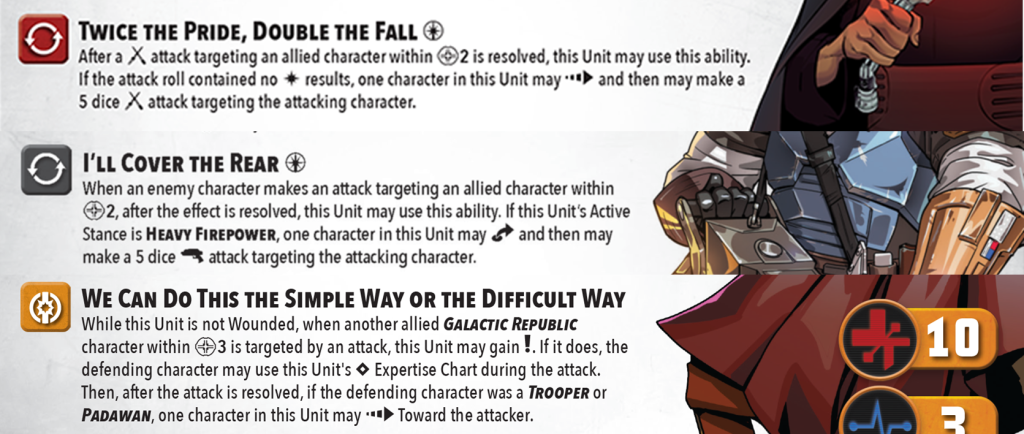
Trending Today

I heard that, much like blue-milk cereal, revenge is best served cold. Now the cover picture makes more sense, right? I believe the meaning of this well-known expression is that you should wait for the heat of the moment to pass so that you can deliver revenge in a cool, collected, and calculated manner at a later time. I try not to be a vengeful guy, so I can’t speak to how well this approach works in the real world. In Shatterpoint, however, revenge is served piping hot, hotter than Uncle Owen and Aunt Beru after a visit from Gary the Stormtrooper. We’ll go more in-depth on the timing shortly, but suffice it to say you will not be waiting long to deliver vengeance upon a character who has wounded your unit.
Revenge is a big part of the meta right now, so today I thought it would be fun to talk about not only the current state of revenge and how to play around it, but also how we got here. Of course, to start we need to define what revenge is exactly and go through some of the rules.
Relatively speaking, I use the term “revenge” a little loosely. I classify revenge as any move and/or attack ability that triggers off a friendly unit becoming wounded. So, for me, something Like The Mandalorian’s This is the Way ability would be revenge, despite not granting an attack, while Luminara’s Flow of the Force is not revenge. The part that triggers when a friendly unit is wounded only gives three heals. While those can be quite handy, it isn’t really really changing any objective math that turn.

The most common trigger for a revenge effect is something along the lines of “when an allied unit is wounded by an enemy effect, after the effect is resolved …” Enemy effects are basically anything an enemy does. This could be an attack, a damage-dealing effect such as Chewie’s It’s Not Wise to Upset a Wookiee, or anything else that an enemy does to damage your units. Critically, though, strain is not an enemy effect. If my Luke has one health left and moves to trigger a strain, taking three damage, it’s the strain that wounded him, and that’s a neutral effect. However, if an enemy would apply a second strain to Luke, giving him one damage instead, that damage is an enemy effect.
Some revenge triggers are more specific. For example, Kanan cares about a unit being wounded “by an enemy attack.” That phrasing is specifically referring to the damage pool being applied in step 9 of the attack.
When the wound is not dealt via an attack, the timing is fairly straightforward. Things get a bit trickier when an attack is involved, and one usually is. Most revenge triggers say “…after the effect is resolved…” When the effect is an attack, they essentially become “…after the attack is resolved…” This means the revenge triggers will slot into the after-attack sequence in step 10 of the attack, step 10d for the defending player specifically. This means that it is now competing not only with similar “after wound” triggers but also “after attack” triggers.

For example, let’s pretend Aurra attacks and wounds General Solo. He has a revenge trigger with Hey, It’s Me that will get filed into step 10d. However, Aurra has multiple possible after-attack triggers. In step 10c she can use Hit and Run to reposition out of Han’s range, avoiding his revenge attack. The important thing to remember here is that a lot of stuff can trigger after an attack, so be aware of that as you plan for revenge triggers, no matter whether you are the wounder or wound-ee.
To understand the present, you must understand the past.
– Lots of people, I assume
Revenge triggers have always been with us – the core set has two, which we’ll investigate in a moment – but it feels like they are much more prominent now, why? A big element of that is that it seems to be a featured part of the rebel identity. Han, Charming Leia, and Kanan are all rebel primaries where revenge is a decent chunk of their kit (OK, maybe that’s being generous with Han). Other than that, I’d say two main reasons are that the abilities are better and the units are better. Let’s examine the “early wave” of revenge units from 2023.
The core set features two characters with revenge mechanics – Lord Maul and Ahsoka Tano, Jedi No More. Maul was, and continues to be, a very popular and often-played primary. However, his aptly named Revenge, I Must Have Revenge ability is kind of an afterthought. Most competitive players will avoid wounding Maul not because of his attack but because then he will pop back up throwing even more melee dice than before. Instead, the best approach is usually to load him up with conditions and nine or ten damage. If you did want to wound Maul then it can still be relatively easy to work around his revenge. Wound him with a non-attack ability, shoot him, melee him but shove him away with a pin, melee him but shove him onto a lower elevation with no ingress around, to name a few examples. Darth Vader, Jedi Hunter released soon after the core set and has a similar revenge ability. There are some improvements, like triggering off any attack type, and some deterioration, costing at least one force to use. All in all, neither Maul nor Vader shift games much much with their revenge abilities.

The other core set character with revenge is primary Ahsoka. Her Fierce Protector ability allows an advance then either three heals or an attack (against the wounder) when an ally is wounded by the enemy. This ability is a great example of many different ways a revenge trigger can be limited. For a melee-only character, the mobility is lackluster, since the advance will often be downgraded to a dash due to engagement. The move also has to be towards the wounder, limiting where Ahsoka can go on the board. Three heals are OK, but it’s within a range 2 bubble of Ahsoka, which is pretty small. A five-dice attack is pretty standard, but her expertise isn’t outstanding (if you want to know more about expertise and five-dice attacks, check out this article). Oh, and if she’s pinned then she doesn’t get the heals/attack at all because there is no “character that moved.”

On the flip side, Dooku released day 1 alongside the core set, and his revenge trigger is pretty good. Force refresh is obviously nice, but a dash or attack from a support means there is some flexibility in how the Dooku player wants to respond. There is a but, though, and it’s so big that Sir Mix-A-Lot can’t hide his thoughts about it. If you wound a support then Brave, But Foolish doesn’t trigger, and wounding supports is usually what you do to beat Separatists (or most factions, really). My joke with Dooku is that his card tells you how to beat him because he incentivizes you to play the type of game that will beat his lists.

To me, Mother Talzin perfectly encapsulates the transition from “early days” revenge to “modern” revenge. She was released relatively early, but after all of the previous examples. After her release, it took a while until we saw revenge come back into the fold. Her ability Wrath of the Great Mother gave us a glimpse of how powerful revenge could be as it combined movement with good expertise and a great combat tree. Yes, you could mess her up by pinning her and yes it had to be a ranged attack, but it’s still a very solid ability. However, the main things that hold Talzin back are her lack of mobility and the fact that non-Maul Dathomirians tend to be pretty meh. She found some competitive success, particularly with Dooku, but revenge had yet to come into its own. What if there could be a character with a similarly good ability that was more flexible than Talzin when it came to their abilities and their strike team? What if there were more than one of those characters, and they could easily go in a list together?

Mother Talzin cracked the lid on Pandora’s Box of Revenge, but the 2024 releases flung it wide open. Not only did squad-wide revenge triggers gain more flexibility, but self-contained revenge, à la Maul/Vader, saw improvements as well.
Remember how limited Ahsoka’s revenge trigger could be? What if it was a reposition instead of an advance, so it was never turned into a dash? What if she could move in any direction? What if she could heal her own pin before moving? What if she had a range 4 bubble to help her friends after moving, instead of range 2? Well, The Mandalorian’s This is the Way ability does all of that. It’s also contained on a unit that brings diceless displacement for one force while being just as tanky as Ahsoka (if not more so). Sure, she has the Galactic Republic tag which helps in list building, but Scoundrel and Bounty Hunter are no slouches these days, and Mando himself can fit into almost any list and be a good contributor. Remember what I said at the top? The revenge abilities are better and the units are better-er.

I’ll group Kanan and Princess Leia, Charming to the Last together in a group I’ll call “similar-ish to Talzin, but in rebels.” Kanan is an absolute beast in that he won’t be slowed by pin/strain/disarm (thanks to the double heal and jump) and can attack any enemy, but he’s relatively tag-limited. However, Spectres on the whole are just much better than Dathomirians. Like Talzin, Kanan brings a diceless displacement option for two force but he is also self-mobile. Leia is similarly mobile, and she doesn’t care much about your tag. There are some pluses and minuses when you compare her revenge to Talzin’s (Talzin has better expertise, can dash any direction, but can’t melee and her attack has less range) but overall Leia is a unit that slots into many more lists than Talzin does. Kanan is less flexible in list building, but if you pair him with the right tags he makes up for that with an incredibly flexible revenge attack.

Another trend we’ve seen with modern revenge is the abilities trickling down to secondaries. For example, Gideon Hask’s May We Live Up to Our Name is arguably an improved version of Maul and Vader’s self-revenge triggers since he can do a ranged attack and he has a double shove to start his tree. Bossk, Single-Minded Slayer has a classic “move and attack” ability when a Bounty Hunter-tagged unit is wounded by an attack. Sure it’s a fairly limited tag, but taking such an ability on a secondary means you still have two powerful primary slots to play with.

A new form of revenge, at least by the definition of revenge we’re using, has cropped up in recent releases as well: “nuh-uh” revenge. Characters like Zeb and Paz can immediately become injured and shed their wounded status, allowing them to continue contesting objectives. Paz even throws in an attack for good measure. Even though nuh-uh revenge isn’t really what I’m looking to talk about in this article, it still furthers my point that you need to consider a lot of effects nowadays before wounding your enemies.

That’s a bunch of new units that have some sort of revenge trigger, way more than in the early days. And we didn’t even discuss them all! The glut of strong revenge units have a somewhat multiplicative effect – they are good on their own, but get better with friends. One unit doing something when you wound their friend is something to consider, but workable. Two units doing something can be a much more complex problem. Heck, I put together a semi-serious list concept where four things happen if you are silly enough to wound Dengar (Mando, Leia, Bossk, and Dengar himself). Combining Dooku and Talzin gave revenge some teeth back in 2023, and now there are many more options to double down on revenge triggers. They are a big part of the meta, so how do we handle them?
Very simply, you need to time your wounds when playing against revenge triggers. That sounds nice, but what does it really mean? Before wounding an enemy, you need to evaluate what threats your opponent presents with their revenge trigger. Ask yourself “If I get this wound …”
That last one is mainly vs. Kanan since he can attack anyone. Generally speaking, revenge attacks will target the character that did the wound. Speaking of which, when wounding with a two-character unit, consider which character you want to get the killing blow. This ties into point #1 below regarding ways to proactively make the revenge triggers less effective:
At the end of the day, one bad turn can be enough to snowball and lose you the struggle. Let’s say your opponent is up 2-1 objectives as you start your turn, and they control the priority objective. If a revenge trigger prevents you from flipping anything then you are only scoring one point, and next turn they have a good chance to score four. That can be hard to come back from. In situations like these, where you can’t afford to trigger revenge, seek alternate solutions. Try to shove the defender away without wounding. Utilize diceless displacement effects like force push. Overwhelm the objective with bodies.
One strange conclusion I’ve come to is that revenge units often have more value when they are not on an objective. This is somewhat paradoxical – isn’t it better to be contesting an objective? Well, sort of, yes. However, once a unit is already on a point, their potential to change the math with a revenge trigger is muted somewhat. If Charming Leia is hanging out on an objective, she might not want to leave that objective to go and attack someone. She may not even be in range to dash onto another active objective. Conversely, if she’s hanging out between two objectives then it’s possible she could move to either on her revenge trigger, which poses more threat.
Of course, you still want to put units on objectives. You need to take and maintain control. However, let’s say you’re activating Hera and you can use her tactic to advance either Sabine or Kanan onto an objective. Kanan can be enticing because he has that defensive dash in his expertise, but he also has ways to move out of activation with revenge triggers. It might be better to move Sabine onto the objective and keep Kanan hanging around one or more objectives.
In a similar scenario, let’s consider a Bossk list where Lando is activating and moving a friend. He could move a Lobot or a Bounty Hunter support. Lobot’s Lockdown ability is really good, but he won’t trigger Bossk’s revenge when wounded. The Bounty Hunter would trigger Bossk, so in some scenarios, it would be advisable to move the Bounty Hunter rather than Lobot. Set your units up to create more headaches for your opponent.
Some other things to consider when building and playing revenge lists:
Here is where I’ll group in a number of effects that trigger off of attacks rather than wounds. Abilities like Dooku’s Twice the Pride, Double the Fall, Paz’s I’ll Cover the Rear, or Plo’s We Can Do This the Simple Way or the Difficult Way can all be a pain in the butt if you’re on the other side of the table. I won’t dive too deep into them here, but some of the principles discussed earlier can still apply.

Note that Dooku and Paz measure distance after the attack is completed, so you can shove a unit out of range 2 to avoid their trigger.
Revenge has come a long way from Ahsoka and Maul in the core set days. Currently, it’s is a big part of the meta thanks to characters like Mando, Charming Leia, and Kanan. Not only do they have strong revenge abilities, but they are also useful and effective characters in their own right. People love to focus on the attacks, and those are certainly impactful, but beware of the moves as well. Bodies getting onto objectives can really mess up a turn, possibly undoing the benefit you got from the wound.
Wounding can still be very effective, even into revenge-focused lists. However, you can’t be haphazard about it. Think through the repercussions before you wound and try to mitigate the usefulness of the revenge triggers when possible. On the other side of the table, try to keep the revenge threat high at all times, and consider your character movements in light of this.


Copyright © 2024 The Fifth Trooper. All Rights Reserved.